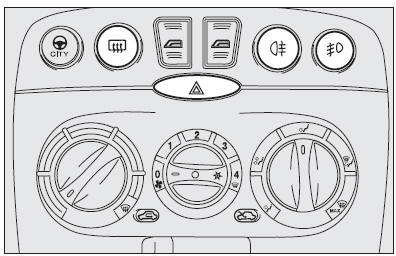
Fiat Punto: Controls
Fiat Punto Owners Manual
HAZARD LIGHTS

They come on when switch  is
is
pressed regardless of the position of
the ignition key.
When the device is on, the switch is flashing and warning lights
 and
and

on the cluster come on.
Press the switch again to turn the lights off.
FRONT FOG LIGHTS (where provided)
Press button  ; to activate these
; to activate these
lights it is necessary to have the
side/taillights switched on and warning light
 on the cluster come on.
on the cluster come on.
Press the button again to turn these lights off.
REAR FOG LIGHT
Press button  ; to activate this
; to activate this
light it is necessary to have the dipped
beam headlights switched onand warning light
 on the cluster come on.
on the cluster come on.
Press the button again to turn these lights off.
HEATED REAR WINDOW
Press button  to turn it on. The
to turn it on. The
device is automatically switched off
after about 20 minutes.
 The use of hazard The use of hazard
lights is governed by the Road Traffic Code of the country you are in. Keep to the rules. |
FUEL CUT-OFF SWITCH (FIS)

It is located under the dashboard on the front right-hand door pillar and it comes into operation in the case of an accident to block the supply of fuel thereby stopping the engine.
Carefully inspect the car to find fuel leaks, e.g. in the engine compartment, under the car or near the tank.
If no fuel leaks are found and the car can be started again, press button (A) to reset the fuel system and the lights.
After a crash, remember to turn the ignition key to STOP to prevent battery run-down.
 If, after a crash, you If, after a crash, you
smell fuel or see leaks from the fuel system, do not reset the switch to avoid fire risk. |
Other info:
Nissan Micra. Exterior front
Engine hood
Windshield
Wiper and washer switch
Antenna
Power windows (if so equipped)
Door locks
Key fob (if so equipped)
Keys
Mirrors
Tire pressure
Flat tire
T ...
Citroen C3. Jack socket
This connection box, consisting of a
JACK socket is located on the centre
console.
It permits the connection of portable
equipment, such as a digital audio player
of the iPod ® type.
It r ...
Chevrolet Sonic. Traction Off Light
This light comes on briefly while starting the engine. If it does not, have the
vehicle serviced by your dealer. If the system is working normally, the indicator
light then turns off.
The tract ...
Manuals For Car Models
-
 Chevrolet Sonic
Chevrolet Sonic -
 Citroen C3
Citroen C3 -
 Fiat Punto
Fiat Punto -
 Honda Fit
Honda Fit -
 Mazda 2
Mazda 2 -
 Nissan Micra
Nissan Micra -
 Peugeot 208
Peugeot 208 -
 Renault Clio
Renault Clio -
 Seat Ibiza
Seat Ibiza -
 Skoda Fabia
Skoda Fabia - Honda Pilot
- Volkswagen ID4
- Toyota Prius


